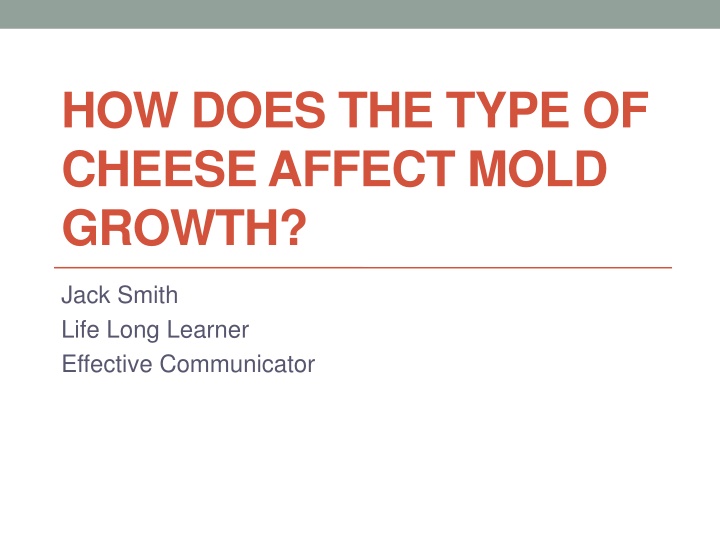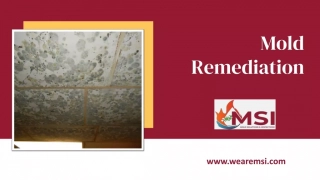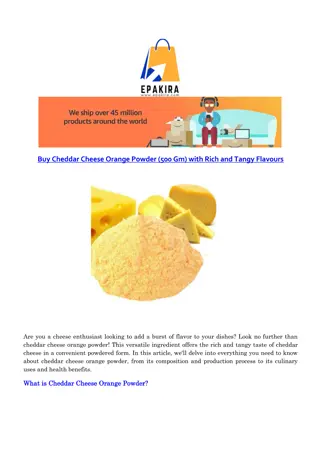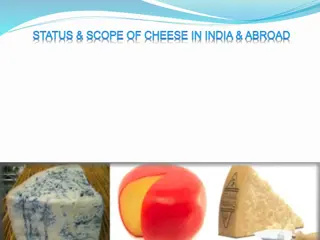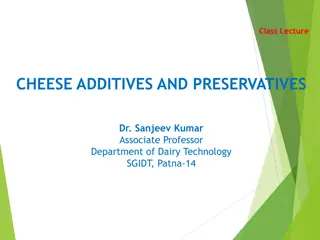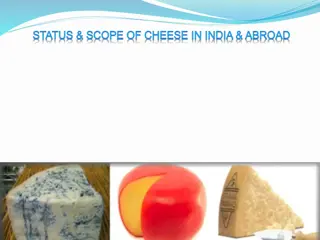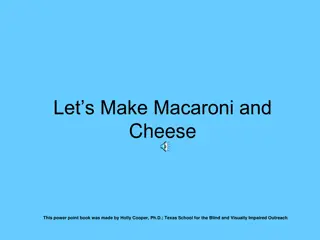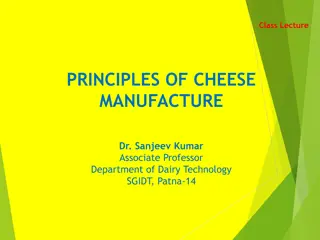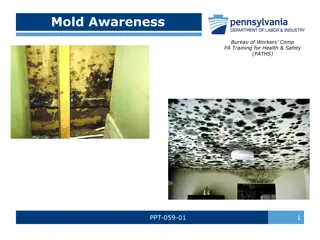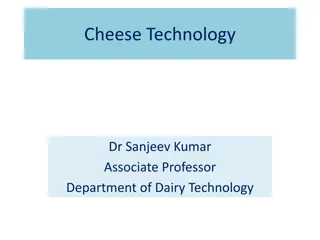How Cheese Type Affects Mold Growth Experiment
The experiment compares mold growth on American, Swiss, and cheddar cheese to determine which type supports more mold. The hypothesis is based on the moisture content of the cheese. Details include experimental design, research references, materials used, and the purpose of the study.
Download Presentation

Please find below an Image/Link to download the presentation.
The content on the website is provided AS IS for your information and personal use only. It may not be sold, licensed, or shared on other websites without obtaining consent from the author.If you encounter any issues during the download, it is possible that the publisher has removed the file from their server.
You are allowed to download the files provided on this website for personal or commercial use, subject to the condition that they are used lawfully. All files are the property of their respective owners.
The content on the website is provided AS IS for your information and personal use only. It may not be sold, licensed, or shared on other websites without obtaining consent from the author.
E N D
Presentation Transcript
HOW DOES THE TYPE OF CHEESE AFFECT MOLD GROWTH? Jack Smith Life Long Learner Effective Communicator
Purpose The purpose of this experiment was to compare the amount of mold growth on three types of cheese (American, Swiss, and cheddar). I became interested in this idea when I found mold all over the cheese in our refrigerator and was concerned because we had just bought the cheese. I wanted to find which cheese to buy to avoid repeating the problem. The information gained from this experiment would help people know which cheese to buy for long term use.
Hypothesis My hypothesis is that American cheese will support more mold growth than the other varieties. I base my hypothesis on The Scientific American article, Who Stole my Mold? , which says, "The more moisture the cheese has, the softer it is." This means soft cheese is moist ,and moisture is what mold needs to grow according to many books I read. American cheese is the softest out of American, Swiss, and Cheddar.
Experimental Design The constants in this study were: The amount of cheese. The storage of cheese slices in individual zip-lock bags. The kind of mold used to inoculate the cheese. The amount of mold spores inoculated on the cheese. The temperature, light, and humidity in the incubation environment. The manipulated variable was the type of cheeses. The responding variable was the rate the mold grew on the cheese. To measure the responding variable I used a transparent grid sheet to determine the approximate number of square centimeters of mold on the cheese each day.
Research and References Gray, William D., What we Find When We Look at Molds, New York: McGraw- Hill Book Company, 1970. Marshall, Robert T., "Cheese", World Book Encyclopedia, 1995, pp. 392- 394. The Growing process of Mold The first stage of mold are the spores. The color of mold comes from its spores. There are thousands of spores that can be caught in a wind current and settle to the floor, food, or the body. Then they break open and start to produce a colony. A colony is where many of the same organisms are growing in the same place. Mold can grow almost anywhere on land or sea. Mold needs a warm dark place to grow. If mold gets too much sunlight, then the mold will not be able to reproduce. Some molds do grow in sunlight, like the molds that kill wheat, oats, roses, and other plants.
Materials QUANTITY ITEM DESCRIPTION 4.5cm x 4.5cm x 0.5cm of Swiss 4.5cm x 4.5cm x 0.5cm of cheddar 4.5cm x 4.5cm x 0.5cm of American Felt tipped marker Sterilized knife Zip-locks Grid Paper rubber glove 4 4 4 1 1 12 1 1
Procedures 1. Take the American cheese and cut four pieces, 4.5 cm long, 4.5 cm wide, and 0.5 cm thick. 2. Apply the mold solution with a cotton tipped applicator across one side in both diagonals on all four pieces of cheese. 3. Put one piece of cheese in each zip lock bag. 4. Label the bags by writing the type of cheese and Trial 1, Trial 2 and so on, on all of the bags 5. Close the Zip-locks making sure there is the least amount of air in the bag. 6. Repeat steps 1-6 for the Swiss and Cheddar cheeses 7. After you applied the mold and waited 24 hours, then place a transparent grid sheet 4.5x4.5 cm over the zip lock and color in the mold pattern. 8. Count the amount of squares and then you will know how much the mold has increased. 9. Do this for every 24 hours for one week. 10.Record your information for Swiss, Cheddar, and American on a graphed piece of paper. 11.Record mold growth data on every piece of cheese every day.
Results The original purpose of this experiment was to discover which cheese (American,Cheddar, and Swiss) would support the most mold growth while in a room temperature cupboard. The results of the experiment were that Swiss grew the most amount of mold, Cheddar had the second greatest amount, and American had the least amount of mold.
Conclusion My hypothesis was that American cheese will support more mold growth than the other varieties. The results indicate that this hypothesis should be rejected because American had the least amount of mold and Swiss had the most. Swiss was the cheese that I hypothesized that would support the least amount of mold growth because of the lack of moisture. The reason there was virtually no mold on the American cheese was perhaps there were preservatives in the cheese. Because of the results of this experiment, I wonder if the American cheese would support more mold than the other varieties without the preservatives or if the cheeses would grow even more mold if I incubated them in warmer area. If I were to conduct this project again, I would make sure that the American cheese had no preservatives.
